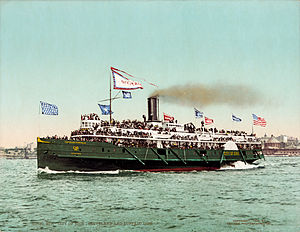The SS City of Erie was a sidewheeler steamboat on Lake Erie. It was famous for being one of the fastest ships on the Great Lakes, at the time. It also won a race against a newer, rival ship.
 Photochrom from 1902 depicting the City of Erie
| |
| History | |
|---|---|
| Name | S.S. City of Erie |
| Namesake | Erie, Pennsylvania |
| Owner | Cleveland Buffalo Transit Company |
| Builder | Detroit Dry Dock Company |
| Launched | February 26, 1898 |
| Maiden voyage | June 19, 1898 |
| Identification | US 127242 |
| Fate | Scrapped in 1941[1] |
| General characteristics | |
| Type | Sidewheel steamer |
| Tonnage | 2,498 GRT[2] |
| Length | 316 ft (96 m)[3] |
| Beam | 78 ft (24 m)[4] |
| Height | 18 ft (5 m) |
| Installed power | 2,200 ihp (1,600 kW) walking beam engine[1] |
| Speed | 17.5 knots (32.4 km/h; 20.1 mph)[5] |
| Capacity | 450 passengers[6] |
Construction
editThe City of Erie was built in 1898 by the Detroit Dry Dock Company in Wyandotte, Michigan, for the Cleveland Buffalo Transit Company (C&B).[1] It was designed by Frank E. Kirby. The ship was launched on February 26, 1898, and made its maiden voyage on June 19, 1898.[6][7]
Operations
editThe City of Erie's route was from Cleveland, Ohio, and Erie, Pennsylvania, to Buffalo, New York. It was nicknamed the "Honeymoon Special" from the number of newlyweds who travelled to Buffalo, bound for Niagara Falls, on the City of Erie.[8] Starting in 1929, the City of Erie operated between Cleveland and Port Stanley, Ontario.[1]
Steamboat race
editAfter a friendly race between the City of Chicago and the City of Milwaukee in September 1900, a Chicago newspaper boasted the winner (the City of Chicago) was the "fastest on the lakes".[8] A paper in Detroit, Michigan, subsequently listed nine other vessels (including the City of Erie) that could have easily beat the City of Chicago. The list failed to mention the newest ship built for Detroit's White Star Line, the Tashmoo. The Tashmoo, also designed by Kirby, was built in 1900 and was built specifically for speed.[8] The president of Detroit's White Star Line offered $1,000 to any ship that could beat the Tashmoo in a race. J. W. Wescott, president of the C&B, accepted the challenge. The set course was 82 nautical miles (152 km; 94 mi) long, going along the City of Erie's regular route from Cleveland to Erie.[8]
The City of Erie was initially ahead but was soon overtaken by the Tashmoo. The Tashmoo eventually slowed and was passed as soon as it was out of sight of the shore because the "wheelman [of the Tashmoo] was not used to steering [only] by compass."[8] The Tashmoo was later forced to slow again due to an overheating condenser.[8] The City of Erie beat the Tashmoo by 45 seconds, with the Tashmoo still gaining ground.[4] The owners of the City of Erie refused to have a rematch, although it was admitted that the Tashmoo was the faster ship.[8]
End of service
editOn September 27, 1909, the City of Erie collided with the schooner, T. Vance Straubenstein. The schooner was sunk, drowning three people.[9]
The City of Erie was retired from service in 1938 and was scrapped in Cleveland in 1941.[1]
References
edit- ^ a b c d e "City of Erie". Marine Historical Society of Detroit. Retrieved January 12, 2008.
- ^ Mansfield, J. B (1899). History of the Great Lakes. Vol. 1. J. H. Beers and Co. OCLC 5721692.
- ^ "Great Lakes Vessels Online Database". Historical Collections of the Great Lakes. Bowling Green State University. Retrieved March 28, 2009.
- ^ a b "Steamer 'City of Erie' wins 100–mile race" (PDF). New York Times. June 5, 1901. Retrieved January 11, 2008.
- ^ Lloyd's Register of British and Foreign Shipping. 1905. p. 848.
- ^ a b "'City of Erie' launched" (PDF). New York Times. February 27, 1898. Retrieved January 11, 2008.
- ^ Rose, Walter Glanson (1990). Cleveland: The Making of a City. Kent, OH: Kent State University Press. p. 589. ISBN 0-87338-428-8.
- ^ a b c d e f g Lochbiler, Don (June 26, 1999). "The race between two centuries". The Detroit News. Archived from the original on January 21, 2013. Retrieved January 12, 2008.
- ^ "Three go down with ship" (PDF). New York Times. September 28, 1909. Retrieved January 13, 2008.